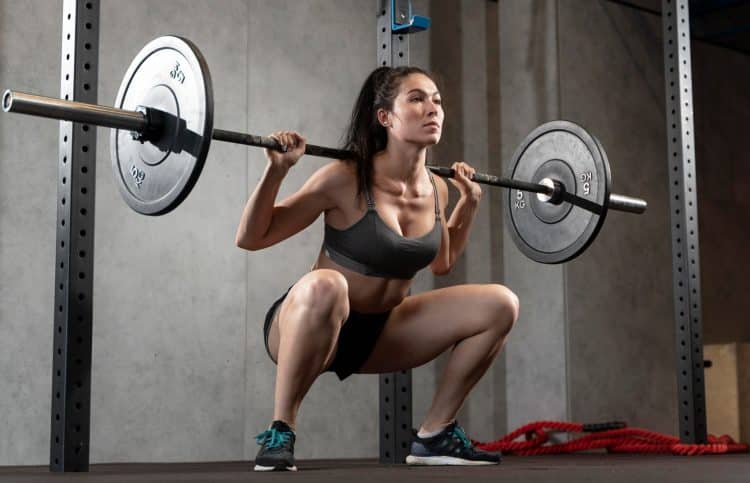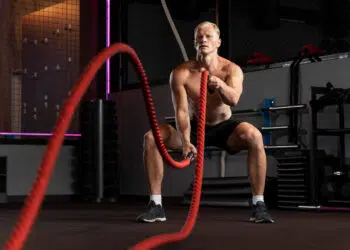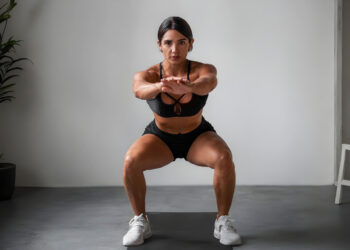I’ve worked in the fitness industry for most of my professional life – that’s over 30 years. Throughout my career, I’ve looked for ways to get the best results for the least amount of training.
That’s not because I’m lazy – far from it – I value hard work. However, I believe that time and energy are valuable resources, and it’s best not to waste them.
In addition, many people state that they don’t have time to exercise. A lack of time is a common reason for missing workouts. Studies suggest that as many as 50% of exercisers give up within 3-6 months of starting a new fitness regimen [1]. To address this, adopting certain strategies can be helpful. For instance, these 7 Proven Habits for More Consistent Workouts can aid in maintaining regular exercise sessions.
More time and energy-efficient workouts make consistent exercise more appealing and manageable.
With that in mind, in this article, I’m going to compare and contrast two time-efficient training methods: high-intensity interval training and high-intensity repeat training. Armed with this information, you’ll be able to choose which one is right for you.
High-Intensity Interval Training Overview
Level Up Your Fitness: Join our 💪 strong community in Fitness Volt Newsletter. Get daily inspiration, expert-backed workouts, nutrition tips, the latest in strength sports, and the support you need to reach your goals. Subscribe for free!
High-intensity Interval Training, known as HIIT for short, has been popular for several decades. But, in case you missed the memo, it’s a form of exercise where participants alternate between short periods of intense activity and brief rests.
For example, you could sprint for 60 seconds, walk for 60 seconds, and repeat ten times to make a 20-minute HIIT workout.
There are lots of ways to do HIIT. Some use cardio activities, while others use calisthenics or strength training exercises. There are also HIIT workouts that combine these training modalities. Check out our article on integrated circuit training to find out more.
The characteristics of HIIT workouts include:
High-Intensity Efforts
It should be no surprise to learn that HIIT workouts feature high-intensity efforts. While you won’t be working at 100% intensity, you will come pretty close. Because of the number of repeats and short rests, you’ll need to hold back a little to ensure you can complete your chosen HIIT workout. Going too hard too soon could bring your workout to a premature end.
Incomplete Recoveries
Rests between HIIT efforts are generally kept short, e.g., 30-60 seconds. As such, you won’t have time to recover fully between intervals. When you exercise intensely, you use the ATP/CP and lactate systems for energy. Both systems take several minutes to recuperate.
As such, you start each interval feeling a little more fatigued. Fatigue levels rise over the course of your workout. This results in a gradual decrease in exercise performance or an increase in heart rate and perceived exertion. Either way, most HIIT workouts start out feeling okay but get very uncomfortable toward the end.
Exercise Discomfort
It’s no exaggeration to say that HIIT workouts hurt – a lot! Near-maximal efforts combined with inadequate rests mean that lactate levels quickly rise. Your muscles burn, your heart pounds and your lungs heave. While some exercisers welcome this discomfort, others find it off-putting.
In fact, less fit exercises may find this level of discomfort intolerable, and it could even be dangerous. Subsequently, HIIT workouts are not generally suitable for novice and very unfit exercisers.
Multiple Intervals
While HIIT workouts are generally shorter than regular cardio, such as LISS and Zone 2 training, they can still be quite lengthy. This is because most involve multiple efforts. For example, you might do 8-10 one-minute intervals with two-minute rests, adding up to about 24-30 minutes.
Of course, there are exceptions to this rule. For example, Tabata intervals last only 20 seconds with ten-second rest periods. A Tabata workout usually only lasts about four minutes. However, the fact remains: most HIIT workouts typically involve multiple intervals.
HIIT Benefits
HIIT workouts offer a range of notable benefits. These include:
- Time-Efficiency: HIIT workouts are generally shorter than traditional cardio workouts. Because of this, they’re ideal for time-pressed exercisers.
- Increased Caloric Burn: HIIT burns more calories per minute than conventional cardio.
- Boosted Metabolic Rate: HIIT can elevate your metabolic rate for hours after exercise, aiding in weight management. This is called the afterburn effect or, more correctly, excess post-exercise oxygen consumption, EPOC for short.
- Improved Insulin Sensitivity: HIIT can improve insulin sensitivity, reducing the risk of type 2 diabetes. Better insulin sensitivity can also enhance fat loss and limit weight gain.
- Improved Cardiovascular Health: HIIT can improve cardiovascular health, increasing cardiorespiratory efficiency and endurance.
- Muscle Building and Maintenance: HIIT can help build or maintain muscle mass, especially when combined with strength training exercises.
- Better Aerobic Fitness: Despite being anaerobic in nature, HIIT can improve aerobic fitness, expressed as a higher V02 max.
- Variety and Flexibility: There are lots of different ways to do HIIT. This variety helps to prevent exercise boredom.
- Mental Health Benefits: HIIT can boost mood and mental health. This is due to the release of endorphins during intense exercise.
Summary: High-intensity interval training (HIIT) delivers an intense training effect in a relatively short time. Involving multiple efforts and short rests, it overloads your ATP/CP and lactate energy systems, leading to an uncomfortable and potentially painful workout.
Related: The Best Metabolic Exercises and Workouts for Women
High-Intensity Repeat Training Overview
High-Intensity Repeat Training, or HIRT, is a lesser-known variation of HIIT. Also known as sprint interval training (SIT), this exercise method looks and feels less demanding than HIIT. And yet, according to studies, it is potentially more effective [2].
HIRT workouts involve very short, maximal-effort sprints alternated with long, near-complete rests. For example, you might do 20-second bike sprints paired with two-minute rests. But, instead of doing ten or more repeats, as you would with HIIT, you just do 4-5.
Some people dismiss HIRT because it doesn’t cause the same degree of discomfort as HIIT. After all, you have to suffer for fitness and fat loss, right? However, despite feeling very different, it seems that HIRT can be as effective as HIIT.
The characteristics of HIRT workouts include:
Maximal Intensity Efforts
HIRT intervals are short, typically 10-20 seconds. As such, you can (and should) push yourself to work as hard as possible. The keyword here is “sprint,” meaning to go as fast as possible. So, don’t hold back – give it all you’ve got. Because of the short interval length, you should be able to maintain your pace for the entire time.
This need for maximal intensity effort will influence what exercises you can use for HIRT.
For example, outdoor sprinting works well, as do bike and rower sprints. However, HIIT-type exercises like burpees and kettlebell swings are less effective, as you cannot go fast/hard enough.
Near-Complete Recoveries
Probably the biggest difference between HIIT and HIRT is the length of the rests. With HIIT, recoveries are short, leading to an accumulation of metabolic waste products. In contrast, HIRT features much longer rests, typically 6 to 10 times your work intervals. So, if you sprint for 15 seconds, your rest periods could be two minutes or more.
Minimal Discomfort
Very short work periods combined with long rests means that very little lactate accumulates during an HIRT workout. Subsequently, your heart and breathing rate increase, but not to the same degrees as HIIT. In short, despite putting in maximal effort, HIRT workouts cause less discomfort and pain.
Relatively Few Intervals
HIRT is all about quality vs. quantity. Consequently, most HIRT workouts are limited to 4-8 repeats. In general, exercisers are encouraged to do less rather than more. You should stop your workout sooner than planned if you notice that your performance is starting to decrease. Ideally, your first interval should be virtually identical to your last.
HIRT Benefits
HIRT and HIIT share several benefits. However, there are some additional advantages to HIRT vs. HIIT. These include:
- Fat burning: Despite the short intervals and workouts, in studies, HIRT reduced body fat by 39% more than HIIT [3]. It’s especially effective for targeting abdominal fat.
- Muscle Gain: Full-speed sprinting challenges your muscles like weight training, targeting the type IIb fast-twitch muscles responsible for size and strength. As such, HIRT can lead to muscle gain.
- Increased Muscle Power: Sprinting is a power activity. Power is force generated quickly. HIRT workouts can improve your ability to jump, kick, dodge, and punch harder, making them especially useful for athletes.
- Shorter Training Time: With shorter intervals and fewer repeats, HIRT workouts are even more time-efficient than HIIT. To be clear, most HIRT workouts are over and done in 10-15 minutes.
- Quick Results: HIRT is so effective that you should see improvements in fitness in four weeks [4]. Such rapid results should be very motivating, improving exercise adherence.
Summary: High-Intensity Repeat Training (HIRT) is even more time-efficient than HIIT. It involves a relatively low number of maximal-intensity efforts combined with long, complete recoveries. This predominately targets the ATP/CP system, which produces no fatiguing waste products. As such, HIRT workouts cause very little exercise discomfort.
HIIT vs. HIRT – My Observations and Experience
While studies are always interesting and provide valuable data, personal experience also matters. I’ve used HIIT and HIRT quite a lot over the last few years, and so have my personal training clients. To that end, in this section, I’m going to share my experiences and observations of these two training methods.
Workout Enjoyment/Satisfaction
Enjoyment plays a big part in exercise consistency. If you dislike a workout, it’s easy to find reasons not to do it. Because HIRT hurts less than HIIT, some people will find it more enjoyable. As such, they’ll be more inclined to do it.
That said, some exercisers actually enjoy the challenge of HIIT and feel a sense of pride and satisfaction after completing such an intense workout.
Your mindset at the time of your workout can also determine enjoyment. For example, if you are feeling positive and energized, you are more likely to rise to the challenge of an HIIT workout. However, if you aren’t “feeling it,” a shorter HIRT, easier session may be more welcome.
Level Up Your Fitness: Join our 💪 strong community in Fitness Volt Newsletter. Get daily inspiration, expert-backed workouts, nutrition tips, the latest in strength sports, and the support you need to reach your goals. Subscribe for free!
Workout Duration
On paper, HIRT is much shorter than HIIT. However, both of these workouts are very time-efficient, so the difference isn’t all that significant.
Because HIRT involves sprinting with maximal effort, most exercisers will need a longer warm-up, which will probably negate any time saved. So, while you may shave a few minutes off your workout with HIRT vs. HIIT, this time saving won’t really amount to much.
Workout Results
Having tried HIIT and HIRT, I found both to be similarly effective. My clients said much the same thing. HIRT is arguably the better option for improving speed and power, while HIIT may have the edge for endurance. That said, any differences were marginal.
But, it’s important to note that HIRT workouts involve fewer intervals and less work. They also feel easier. From a cost vs. results perspective, this means that HIRT is actually more effective.
Effects on Appetite
A tough HIIT workout always makes me feel hungry. As soon as I’ve cooled down, I feel like I need to eat. This is probably because HIIT workouts deplete your glycogen levels, which is what we call the glucose stored in your muscles and liver. For me at least, glycogen depletion tends to trigger carbohydrate cravings.
In contrast, HIRT workouts do not affect my post-training appetite. HIRT involves a low number of short intervals, which probably won’t make much inroad into your glycogen stores. This may explain why some studies found that HIRT was better for fat loss than HIIT [3].
Related: Fix your Diet Forever in Six Weeks!
Workout Timing
In my experience, HIIT is best done separately from strength training. For example, you could lift weights one day and do HIIT the next. This approach ensures you can put maximal effort into both types of workout. Of course, this also means you’ll need to commit to training on most days of the week.
In contrast, most people find they can do HIRT after strength training. This is because the intervals are shorter and less numerous, so they require less energy. In short, they’re easier to do even if you are tired.
Because of this, you may not need to train so many times each week. This may be an advantage for those who are unable to commit to more frequent workouts. Also, doing HIRT after strength training means you won’t need much of a warm-up.
Safety and Injury Risk
HIRT workouts involve short but maximal-intensity intervals. Each one only lasts 10-20 seconds, so you’ll need to work extremely hard to reach the required level of exertion.
This amount of effort puts a lot of stress on your muscles and joints, potentially increasing your risk of injury. Because of this, I prefer to use low-impact exercises such as cycling and rowing for HIRT. They’re much safer than outdoor sprinting.
In contrast, HIIT workouts involve lower-intensity efforts but more fatigue. This can lead to poor technique, which is another potential cause of injuries. However, you can minimize this risk by choosing exercises and activities with low skill requirements.
Ultimately, HIIT and HIRT can cause injuries, but the risk may be slightly higher for HIRT. That’s especially true if you sprint outdoors, and hamstring injuries are common in sprinters.
Effects on Recovery
HIIT can be very tiring. It can take several days to recover from a demanding HIIT workout. This, in part, is due to the degree of glycogen and muscle damage this type of workout causes. In contrast, HIRT seems to be easier to recover from. It’s not as draining or fatiguing and doesn’t cause so much glycogen depletion.
Because of this, you should recover faster from HIRT than HIIT. Consequently, HIRT should have less of an impact on subsequent workouts, and you may even be able to do it more often than HIIT. However, recovery between workouts is still critical for your progress, and doing too much could lead to overtraining.
HIIT vs. HIRT – Which One Should You Do?
In conclusion, HIIT and HIRT are both effective, time-efficient workout methods. While some studies suggest that HIRT may be better than HIIT for fitness and fat burning, real-life experience suggests these methods produce very similar results. So, pick the one you like best, or do them both. Either way, you’ll get a great workout!
HIIT vs. HIRT – FAQs
Do you have a question about HIIT vs. HIRT? No problem, because we’ve got the answers! Need more information? Drop me a line in the comments section below, and I’ll get back to you ASAP.
1. I tried HIRT and found it easy. Is it really effective?
Many exercisers believe in the concept of no pain, no gain. They assume that effective workouts have to hurt. However, this is not necessarily the case. Allow me to use an analogy to better explain what I mean.
Imagine a bullet in a gun. To fire that bullet, you pull back the hammer and let it drop on the firing pin. This starts a chemical reaction that produces a gaseous explosion that sends the bullet out the end of the gun barrel. Pull the hammer and drop it on the same shell again, and you’ll get nothing but a click.
In the same way, once a workout reaches a certain threshold, it triggers the adaptations responsible for improving your fitness. Doing more of the same workout may not produce better results. You need to rest and reload so you can fire off another shot at a later time.
Needless to say, this is a metaphorical comparison, not a lesson in ballistics, so please excuse any inaccuracies re. how bullets and firearms work.
So, the idea that a workout has to be hard to be effective is flawed. A workout is a stimulus for change, and evidence suggests that something short but intense, like HIRT, is enough to start the process of getting fitter and stronger. So, don’t worry that HIRT feels easier than HIIT; that doesn’t mean it’s ineffective.
2. What is the best way to warm up for HIIT and HIRT?
Warming up prepares your muscles and joints for the activity to follow. Both HIIT and HIRT put a lot of stress on your body, so it’s critical to warm up before either of these workouts. A good warm-up will also maximize cardiovascular efficiency, making your session more effective.
The best way to warm up for HIIT and HIRT is with a few minutes of light cardio, followed by dynamic mobility and flexibility exercises for the muscles and joints you are about to use. You can also practice the activities you are about to perform, ensuring you are comfortable and familiar with what’s going to follow.
Finally, especially for HIRT, you should do a few progressively faster efforts to get your body ready for the demands of your workout. For example, if you are doing rower sprints, you could do a slow, medium, and fast-paced effort before you begin your session.
3. What are the key differences between HIIT and HIRT?
Here’s a simple chart comparing HIIT vs. HIRT. Use it to see how things like intensity, recovery, and duration vary between these similar workouts.
| Aspect | HIIT | HIRT |
| Intensity of Efforts | High but not maximal to allow for repeat intervals | Maximal, push as hard as possible in short bursts |
| Rest Periods | Short (30-60 seconds), leading to incomplete recovery | Long (often 6-10 times work interval), allowing near-complete recovery |
| Discomfort | High due to lactate accumulation; potentially painful | Minimal, prevents significant lactate build-up |
| Number of Intervals | Multiple intervals, usually 8-10 or more | Few, usually between 4-8 |
| Workout Length | Varies, often around 20-30 minutes | Shorter than HIIT, typically 10-15 minutes |
| Benefits | Time efficiency, increased caloric burn, elevated metabolic rate post-exercise, improved insulin sensitivity, cardiovascular health, muscle building, and mental health benefits | Shares HIIT benefits, plus greater fat burning, muscle gain, increased muscle power, quick fitness improvements |
4. Are HIIT and HIRT suitable for all exercisers?
HIIT and HIRT are demanding workouts. As such, they are only safe and suitable for reasonably fit, experienced exercisers. They are probably too intense for most beginners. Exercise newbies should develop their basic fitness with regular cardio before progressing to either HIIT or HIRT.
Other groups who should avoid HIIT and HIRT include:
- Individuals with heart and circulatory conditions
- Pregnant individuals (especially in the later stages or with complications)
- Individuals with chronic fatigue syndrome
- Very deconditioned or sedentary individual
- Individuals with joint disorders
- Individuals with musculoskeletal injuries
- Type 1 diabetics (without careful medical supervision)
- Individuals with respiratory conditions
- Individuals recovering from recent surgery
5. Can HIIT and HIRT be combined with a strength training program?
HIIT and HIRT are very compatible with a strength training program. Adding either of them to your workout schedule will enhance your progress. They’ll increase your work capacity, burn fat and calories to help you get lean, and they’re good for your health, too.
However, you’ll need to consider their impact on your strength training workouts and organize your training week to avoid clashes. For example, you should keep HIIT/HIRT away from your leg workouts. Also, make sure that you still leave time in your schedule for rest and recovery.
All of that said, incorporating HIIT or HIRT into your training plan can be very beneficial, and I highly recommend it.
HIIT vs. HIRT – Closing Thoughts
HIIT and HIRT are both effective and time-efficient. HIRT delivers a shorter workout that feels somewhat easier. This is good news for those of us who don’t want to suffer for our fitness.
In contrast, HIIT workouts are a little longer and feel much more challenging. However, they also deliver an almost unbeatable sense of achievement and satisfaction. Despite their differences, both workouts provide similar results.
So, which one should you do? That’s a hard question to answer because it depends on numerous factors, including your personality and mindset, how much discomfort you can tolerate, and how hard you like to push yourself. I suggest you try them both so you can experience them for yourself. That way, you’ll be able to make an informed decision.
Just remember, more exercise is not always better, so if you’re looking for the workout that provides the biggest bang for your buck, HIRT is arguably the way to go.
References:
- Vancampfort D, Sánchez CPR, Hallgren M, Schuch F, Firth J, Rosenbaum S, Van Damme T, Stubbs B. Dropout from exercise randomized controlled trials among people with anxiety and stress-related disorders: A meta-analysis and meta-regression. J Affect Disord. 2021 Mar 1;282:996-1004. doi: 10.1016/j.jad.2021.01.003. Epub 2021 Jan 6. PMID: 33601745.
- Naves JPA, Viana RB, Rebelo ACS, de Lira CAB, Pimentel GD, Lobo PCB, de Oliveira JC, Ramirez-Campillo R, Gentil P. Effects of High-Intensity Interval Training vs. Sprint Interval Training on Anthropometric Measures and Cardiorespiratory Fitness in Healthy Young Women. Front Physiol. 2018 Dec 5;9:1738. doi: 10.3389/fphys.2018.01738. PMID: 30568598; PMCID: PMC6290642.
- Tong TK, Zhang H, Shi H, Liu Y, Ai J, Nie J, Kong Z. Comparing Time Efficiency of Sprint vs. High-Intensity Interval Training in Reducing Abdominal Visceral Fat in Obese Young Women: A Randomized, Controlled Trial. Front Physiol. 2018 Aug 3;9:1048. doi: 10.3389/fphys.2018.01048. PMID: 30123136; PMCID: PMC6085472.
- Willoughby TN, Thomas MP, Schmale MS, Copeland JL, Hazell TJ. Four weeks of running sprint interval training improves cardiorespiratory fitness in young and middle-aged adults. J Sports Sci. 2016;34(13):1207-14. doi: 10.1080/02640414.2015.1102316. Epub 2015 Oct 30. PMID: 26514645.











